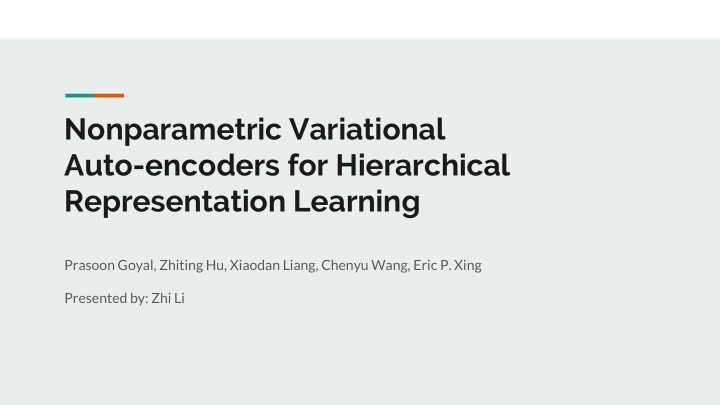



Nonparametric Variational Auto-encoders for Hierarchical Representation Learning Prasoon Goyal, Zhiting Hu, Xiaodan Liang, Chenyu Wang, Eric P. Xing Presented by: Zhi Li
Motivation Variational Autoencoders can be used for ● unsupervised representation learning However, most of these approaches employ ○ a simple prior over the latent space It’s desirable to develop a new approach ● with great modeling flexibility and structured interpretability Variational Autoencoder Explained. Retrieved from http://kvfrans.com/content/images/2016/08/vae.jpg
Hierarchical nonparametric variational autoencoders Bayesian nonparametric prior ● Allows infinite information capacity to ○ capture rich internal structure of the data Hierarchical structure ● serves as an aggregated structured ○ representation coarse-grained concepts are higher up in the ○ hierarchy, and fine-grained concepts form their children
Nested Chinese Restaurant Process Similar to CRP, but imagine now that tables ● are organized in a hierarchy Each table has infinite number of tables ○ associated with it at the next level Moving from a table to its sub-tables at next ○ level, the customer draws following the CRP nCRP defines a probability distribution ● over paths of an infinitely wide and infinitely deep tree Nested Chinese Restaurant Process. From: DAVID M. BLEI “The nested Chinese restaurant process and Bayesian inference of topic hierarchies”
Stick-breaking Interpretation
nCRP as the Prior Image we have an infinitely wide and infinitely deep tree For every node p of the tree, it has a parameter vector , which depends on the parameter vector of its parent node to encode the hierarchical relation For the root node, we set
nCRP as the Prior We can now use this tree to sample a sequence of latent representation through root-to-leaf random walks along the paths of the tree. For each sequence x m , draws a distribution, Vm , over the paths of the tree based on nCRP ● For each element x mn of the sequence, a path c mn is sampled according to the distribution Vm ● Draw the latent representation z mn , according to the parameter associated in the leaf node of the ● path c mn
Parameters Learning The paper uses alternating optimization to jointly optimize for the neural network parameters (the encoder and the decoder) and the parameters of the nCRP prior. first fix the nCRP parameters and perform backpropagation steps to optimize for the neural ● network parameters then fix the neural network, and perform variational inference updates to optimize for the nCRP ● parameters
Variational Inference for nCRP The trick is to derive variational inference on a truncated tree Variational inference - - to approximate a conditional density of latent variables ● It uses a family of densities over the latent variables, parameterized by free “variational parameters”, and ○ then find the settings of the parameters that is closest in KL divergence to the density of interest The fitted variational density then serves as a proxy for the exact conditional density ○ Truncated tree -- instead of an infinitely wide and deep tree ● If the truncation is too large, the algorithm will still isolate only a subset of components ○ If the truncation is too small, the algorithm will dynamically expand the tree based on heuristic during ○ training
Encoder and Decoder Learning Similar to standard VAE, the object is to maximize the lowerbound of data log-likelihood Parameters are updated using gradient descent
Experiment Evaluate the models on TRECVID Multimedia Event Detection 2011 dataset. ● Only use the labeled videos: 1241 videos for training, 138 for validation and 1169 for testing ○ Each video is considered as a data sequence of frames ○ One frame is sample from the video every 5 seconds, and each frame is used as the elements within the ○ sequence A CNN (VGG16) is used to extract features and the feature dimension is 4096 ●
Video Hierarchical Representation Learning For each frame, the model obtain the latent ● representation z of the frame feature then find the node to which it’s assigned by ● minimizing the distance between the latent representation z and the node parameters
Likelihood Analysis Test-set log-likelihoods comparison between the model “VAE-nCRP” and traditional variational autoencoder “VAE-StdNormal”
Classification Assigns the label to each node (either leaf ● nodes or internal nodes) by taking a majority vote of the labels assigned to the node Predicts label of a frame is then given by the ● label assigned to the closest node to the frame
Takeaway The paper presented a new unsupervised learning framework to combine rich nCRP prior with VAEs This approach embeds the data into a latent space with rich hierarchical structure, which has more abstract concepts higher up in the hierarchy ● less abstract concepts lower in the hierarchy ●
Recommend
More recommend